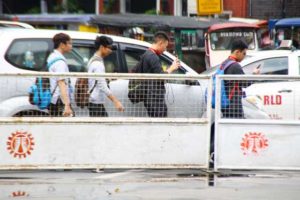SOMETHING changed on the streets of Manila this week.
On sidewalks and at water tanks, churches, parks and other public places, students and office workers mill about, their heads bowed to their smartphones. But it’s not because they’re monitoring important calls or messages.
Manila’s “trendy zombies,” as they are called on social media, are now on a constant hunt for digital monsters, joining legions of aspiring “trainers” worldwide hooked on American game developer Niantic’s Pokémon GO.
The highly addictive and distracting game has forced at least two organizations—the Metropolitan Manila Development Authority (MMDA) and the Asian Development Bank (ADB)—to ban it during work.
ADB announced the policy in a morning e-mail newsletter to employees on Thursday.
To set an example to everyone, the MMDA has also barred traffic enforcers and all other personnel from catching Pokémon creatures, said Goddess Hope Oliveros-Libiran, acting director of MMDA’s Public Information Office.
“We know it’s a craze right now. We don’t want our personnel joining the bandwagon and be seen playing the game while on duty,” Libiran told The Manila Times.
Using “augmented reality” and GPS signals, Pokémon GO allows players to “catch” digital creatures popping out on their smartphone cameras from various locations.
Players are also on the lookout for countless “PokéStops” to get “Poké Balls” needed to catch digital monsters, and “Poké Gyms” where the creatures can train and battle.
Pokémon locations were placed at ADB and MMDA offices, prompting the workplace ban.
On Facebook, users complained of various hazards posed by the game: people crossing the streets while glued to their phones, and vehicles stopping by the roadside to catch Pokémon, swipe PokéStops and visit gyms.
The danger of driving while hunting Pokémon has prompted Niantic to update the game software this week to detect players moving too fast and repeatedly remind them to keep their eyes on the road. It was only last Friday when Pokémon GO was launched in the Philippines and 14 other countries and territories, a month after debuting in the US and Europe.
The MMDA has so far not apprehended motorists caught playing the game while driving.
But it has reminded Pokemon “trainers” to refrain from playing while crossing the street.
For those who can’t help but use the app while crossing busy intersections, the MMDA recommends that players use footbridges.
The MMDA also said users should avoid trespassing and be on the lookout for thieves.
MMDA Chairman Emerson Carlos has warned Pokemon players caught “playing while driving” that they face a fine of up to P15,000 for violating the Distracted Driving Act.
The MMDA Anti-Illegal Parking Operations Team and others have been placed on the lookout for illegally parked vehicles.
But some motorists are ignoring the warnings and say Pokémon GO has made Manila’s horrendous traffic bearable.
“Because of Pokémon Go, Metro Manila’s traffic has given us a huge favor—it’s okay to be late as long as you get to a PokéStop,” said a player from Bataan.
“Perks of Metro Manila traffic: caught almost 50 Pokémons on the road,” another player said.



